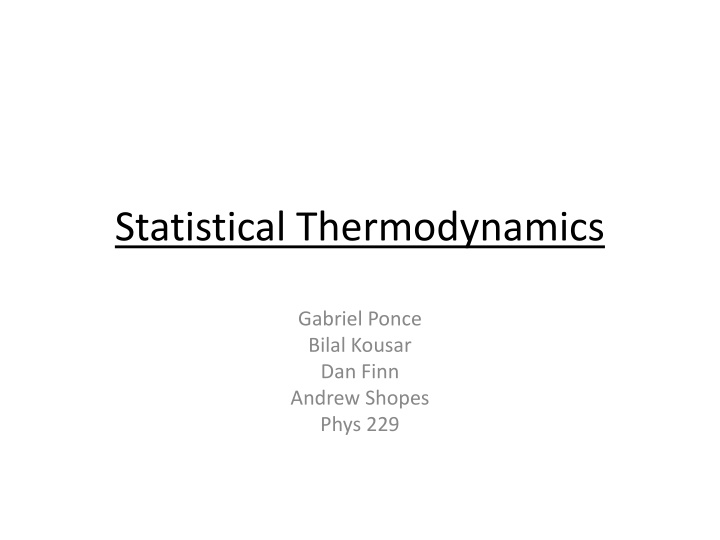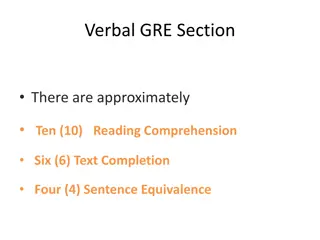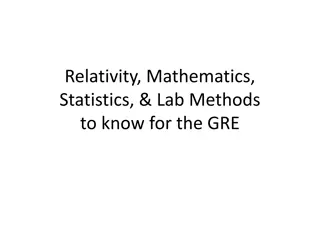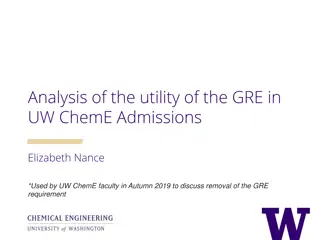
Thermodynamics and Statistical Mechanics Theory
Discover the fundamentals of statistical thermodynamics, ideal gases, important thermodynamic processes, and statistical mechanics methodology. Learn about key definitions, equations, and processes that govern energy, entropy, and work in systems.
Download Presentation

Please find below an Image/Link to download the presentation.
The content on the website is provided AS IS for your information and personal use only. It may not be sold, licensed, or shared on other websites without obtaining consent from the author. If you encounter any issues during the download, it is possible that the publisher has removed the file from their server.
You are allowed to download the files provided on this website for personal or commercial use, subject to the condition that they are used lawfully. All files are the property of their respective owners.
The content on the website is provided AS IS for your information and personal use only. It may not be sold, licensed, or shared on other websites without obtaining consent from the author.
E N D
Presentation Transcript
Statistical Thermodynamics Gabriel Ponce Bilal Kousar Dan Finn Andrew Shopes Phys 229
General Terminology KEY Definitions E or U = internal energy Q = heat added W = work (done by the system) S = entropy m = mass c = specific heat Omega = number of micro states Conservation of Energy Work Heat Entropy Specific Heat
Ideal gases Equation of state for ideal gas Symbol Name Units P Pressure P = F/A ,atm, V Volume L , m^3 n # of Mole 1/Na Internal energy of monoatomic molecule R Gas Constant 8.3145 J/(mol*K) N # of molecules 1+ K Boltzmann constant 1.38065*10^-23 J/K T Temperature Kelvin
KEY E or U = internal energy Q = heat added W = work (done by the system) S = entropy m = mass c = specific heat Omega = number of micro states Ideal gases To find Vrms, Set kinetic energy = internal energy
Important Thermodynamic Processes Isobaric Constant pressure dP=0 [barometer] Isothermal constant T, dT=0 Isochoric constant V, dV=0 [choros = space] Adiabatic (isolated process) dQ=0, no exchange between the system and its surroundings. Adiabatic constant For Adiabatic Expansion, the expressions to the right are equal to a constant
Important Thermodynamic Processes (cont.) Reversible proceeds in infinitesimal step such that each step can be reversed. I.E. adding an infinitesimal amount of heat Quasistatic process that happens infinitely slow such that the system is always at equilibrium All Reversible processes are Quasistatic, but some quasistatic processes can be non- reversible Isentropic aka revisable adiabatic All Adiabatic processes that are reversible must have a dS=0 Warning, the GRE is known to simply say adiabatic and mean reversible adiabatic Recall Adiabatic constant Free Expansion This is an adiabatic process and NOT reversible in which the gas does no work PV=P V .. dU=0, dQ=0 Therefore NkT=Constant
Statistical Mechanics Methodology 1. Specify the macrostate and accessible microstates of the system 2. Choose the ensemble 3. Calculate the mean values and other statistical values Macrostate Microstates 3 non interacting spins in magnetic field B ?????? = B ,N = 3 E = B , = 3,Ps = 1/ ? = B ? = B Statistical properties 3 ???1,?= (1/3) [2 (+1)+ 1 ( 1)] =1 3 < ?1>= < Q >= ?? ?? (Average value of spin 1) 3 ?=1 ?=1 ? 2 and1 = ?1, ?2, =2 3 2 3=4 ?1, =2 ? 2, |1, =1 (Probability that if spin 1 is up then spin 2 is also up) 9 3 2
Canonical Ensemble (fixed T, V, and N) The system of interest is in contact with heat bath, which is sufficiently large that it s not affected by the smaller system ?total= ??+ ?? where ??<< ? Microstates: For a given microstate of the system the heat bath can be in any of the large number of microstates such that the total energy is E Number of microstates of heat bath = ? ? ?? Macrostate: E, V, N Statistical properties: Probability that the system is in microstate s with energy ?? is given by ??=1 ? ? ?? ?? ? ?? ??=1 ?? ??? Boltzmann distribution , ?? is decreasing function because the larger the value of ??, the less the ?? is 1 where ? = ?? and ? = sum over states or partition function ? ??? ?? ??? ? ??? ??= 1 so ? = and ??= ? ? Now since we have the probability distribution, we can find mean values and other stats ????=1 ??? ???= ? ?2? ??2, ??=?<?> 1 < ? >= ??ln? ? < ?2> = similarly =[<E2>-<E>2] ? ?? ? ? ?? ?? ?? ?? ? = ,? = Free energy = ? = ? ? ln? ?,? ?,? Aside: ? = ?ln?
Partition Function Example Consider a system consisting of two distinguishable particles. Each particle can be in one of the two microstates with single particle energies 0 and . The system is in equilibrium with a heat bath at temperature T. What are the thermodynamic properties of the system? Microstates: 0,0 , 0,? , ?,0 , ?,? 4 ? ???= 1 + ? ??+ ? ??+ ? 2??= 1 + ? ??2 ?2= Partition function for two particles ?=1 2 ? ? 0+ ? ??= 1 + ? ?? ?1= Partition function for one particle ?=1 ?2= ?12 and in general ??= ?1? for distinguishable particles So since ?2 is related to ?1 so we can consider the statistical properties of the system consisting of one particle with ?1 ?1=? ? 0 ?2=? ?? ? ?? 1 + ? ?? 1 = 1 + ? ?? probability that a particle has energy 0 , = ?1 ?2 2 ?? ?? 1 + ? ?? and < ? >= 2 < ? > and in general for ? distinguishable particles Partition function of simple harmonic oscillator : ??= ? +1 < ? >= ????= < ? >= ? < ? > ?=1 ? 2 ? ? 1 ? ? ? ? 2 ? ? ? ?+ 1 2= ?1= ?=0
Law of Thermodynamics Zeroth: If two systems are each in thermal, mechanical, and/or diffusive equilibrium with a third system, then they are all in equilibrium with each other. First: Conservation of Energy dE = dQ dW + dN = SdT pdV + dN Second: dS 0 i.e. Entropy is always increases ? ?? ? Third: S(0 K) = 0
Heat Capacity 1 ? ?? ??? Isochoric ??= ??=5 2??? 1 ? ?? ??? Isobaric ??= ??=3 2??? ? =?? ??=5 3
Einstein and Debye Einstein Each particle is a simple harmonic oscillator Used for low temperature systems Debeye Considered the density of states instead of assuming atoms have same E Found correct behavior as T 0 where
Practical Use of Specific Heat ? = ??? ? ??? ? ????? = ??
P-V Diagrams Isothermal Constant temperature Isobaric Constant pressure Adiabatic - No energy transferred as heat ???= ????? Isochoric Constant volume Isentropic Both adiabatic and reversible ? = 0 Some past GREs assume adiabatic is reversible.
More Terminology for P-V Free Expansion Gas suddenly expands ?? = ? ? Quasistatic Process Happens infinitely slowly Always in thermodynamic equilibrium Reversible processes are always quasistatic Reversible Process System is at equilibrium at each step of process Process can be reversed by changing the state of system ?? = ??? ? = ?? ? Note: If dQ < 0 , dS is negative
Carnot Engine Ideal engine Reversible Cycle: Isothermal Expansion Adiabatic Expansion Isothermal Compression Adiabatic Compression ? = ? = ??? = (?? ??)(?2 ?1) Work is area inside T-S or P-V diagram
Efficiency ? =? =? ?? ? = 1 ?? ? ?
Helmholtz Free Energy Thermodynamic potential that measures maximum reversible work obtainable from a closed system at a constant temperature U= Internal Energy S=Entropy For the isothermal change from one state to another: We can then describe the system as spontaneous (F<0), at equilibrium (F=0), and Nonspontaneous (F>0)
Gibbs Free Energy and Enthalpy Thermodynamic potential calculates maximum reversible work from a closed system at a constant temperature and pressure ? = ? ?? + ?? The same concepts in Helmholtz energy apply here ? = ? ? ? + ? ? Enthalpy is the measurement of the total energy of a thermodynamic system ? = ? + ??
Blackbodies Total power emitted by a blackbody: ? = ????4 Using Wein s displacement Law: ????=2.9 10 3 ? ? ? Planck distribution for intensity of light emitted by a blackbody. ? ?,? =2 ?3 1 ?2 ? ?? 1 ?
Phase Diagram Triple Point: Point at which the T and p of a substance cause a thermodynamic equilibrium in which all three phases coexist. Critical point: Point at which liquid and vapor phases coexist, past which a supercritical fluid exists.






















